Falklands War: HMS Sheffield - a survivor's story
- Published
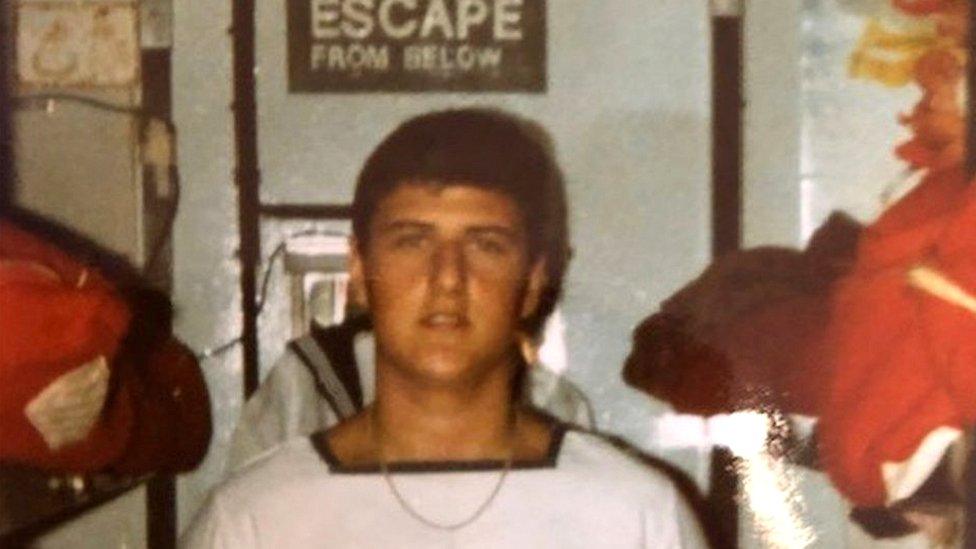
Andy Stephenson, 18, found HMS Sheffield was suddenly diverted to the South Atlantic in 1982
It was April 1982, and the crew of Royal Navy destroyer HMS Sheffield was heading home after a six-month overseas deployment. But the ship's company was suddenly told they were not going to see their families but sailing straight to a group of remote islands about 8,000 miles away. For some of the young sailors on board the trip would be their last. For the rest, the fateful diversion would mark the start of a life-changing series of events.
Sailing on a ship named after his home city was an "amazing feeling", says Andy Stephenson.
Just 18 years old, Andy was part of the HMS Sheffield's logistics staff - one of the vessel's crew of about 280 sailors.
They were making their way home after a six-month mission when the captain made a sudden announcement. Rather than head home, the ship was to take a new course to the South Atlantic.
Andy wondered exactly where the ship was going.
"I had no idea where the Falklands were", he says.
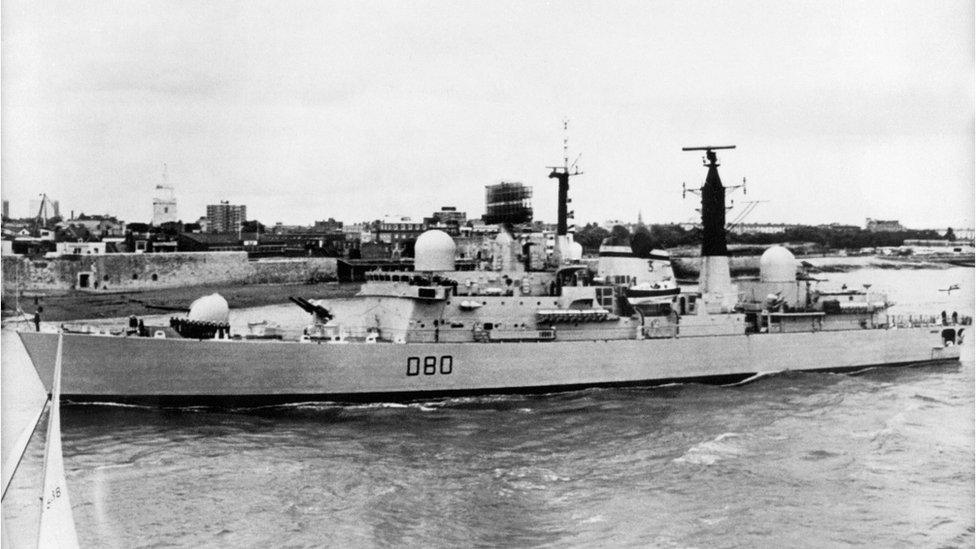
Andy Stephenson served on the ship named after his home town
The destroyer was to form part of a taskforce created in response to Argentinian forces' invasion of the Falkland Islands on 2 April 1982. Isolated and sparsely populated, they are a British overseas territory and have been the subject of a long-running sovereignty dispute.
On HMS Sheffield, the crew were instructed to write a final letter.
"For the first time ever you didn't know if you were coming back", says Andy.
"It was a really morbid letter and it was weird to write but we were all convinced on board it would be sorted diplomatically."
However, those efforts came to nothing and HMS Sheffield found itself sailing into a war zone.
"You grew up very quickly once you are sleeping fully clothed in action dress ready to go", says Andy.
The burnt-out hulk of HMS Sheffield a few days after she was abandoned
As the stress of being a potential target mounted, Sheffield, a type-42 destroyer, was tasked with protecting aircraft carrier HMS Hermes and was "at the front of any action", Andy says.
"At action stations on a warship you are getting a running commentary from the captain on the bridge. 'Missile released coming toward us... 50...40...30 miles.'
"And you tense up but then one of our Seaharrier planes took out the missile and you carry on as normal.
"Those situations were worse then when the missile hit."
On 2 May, news broke that General Belgrano, the Argentinian flagship, had been sunk by submarine HMS Conqueror, killing more than 300 sailors.
"I can remember the elation and cheering at what we had done," says Andy. "Then came the flipside. That's when you start to battle with yourself... I can't believe I am cheering the loss of life but that's war."

Andy Stephenson on the flight deck - from where he was later to plunge off the ship
By Tuesday 4 May the enemy seemed to have recovered form the shock of the sinking and was making counter-attacks.
"They launched hell and fury", recalls Andy.
That afternoon he was off-duty in his bunk when Sheffield was hit.
"There was an almighty blow-out and then I was sucked back into the mess, I heard no bang," he says. "I came to, didn't know what happened but the mess door was blown off. Then the strangest five or six hours of my life happened.
"Out from the mess all the bulkhead doors were open and black pungent smoke was slowly coming towards where we were. We all hit the deck as there was a six-inch gap of clear air", he says.
Andy and his stunned messmates made their way slowly, feeling their way along over bulkheads to a ladder, up which they fought their way to the upper deck.
"I was confronted by a perfect blue, flat sea, blue sky and this massive burning hole in the side of the ship where the missile came in but we were still afloat", he says.

HMS Sheffield after the Exocet missile strike in May 1982 that killed 20 and injured 26 of its crew
In a combat zone Andy had additional duties and was part of the ship's first-aid party. This meant he went into the destroyer several times to rescue both people and breathing apparatus.
"I was ordered back into a burning ship and obeyed that order, putting my life at risk" he says.
Then the time came to get off the still floating but stricken ship.
"The sensible people formed an orderly queue and climbed on to the hangar roof and then jumped across to HMS Arrow alongside", Andy says. "What silly-chops did... I thought the ship was going down so I ran across the flight deck, I had lost all sense of fear and danger, I needed to survive.
"I ran across to the edge of the ship and as I went to leap to Arrow I slipped and, doing a Superman impression, I just caught her rail but was dangling between two ships. They came together and started to crush my legs but a wave took them apart and a guy got hold of me and dragged me over."
He had made it off the ship in which 20 of his crewmates were killed. The losses included Andy's friends and messmates.

The conflict
Britain has controlled the Falklands since 1833
Argentina claims the territory - which it calls the Malvinas - saying it inherited rights to them from Spain
Argentinian forces invaded the Falkland Islands on 2 April 1982
A British taskforce was sent to the area and regained control of the islands in June
There were 255 British servicemen who died in the Falklands War during the 74-day conflict
Three islanders also died
The number of Argentinian dead was estimated at about 650.

Safe on board HMS Arrow, his next job was to provide a tally of surviving crew members. He went round the survivors and carefully made a full list of all the ship's company on the rescue vessel.
"I hand-wrote all the names" and that important list went back to headquarters, he remembers. But he made one unfortunate mistake.
"The first my parents heard was a knock on the door by a vicar and a policeman saying 'your son is missing presumed dead'.
"I'd missed my own name off the list."
When Andy compiled a second list, this time he included himself. Several hours after the first distressing call his parents, who had collapsed with grief, got another message telling them he was alive.
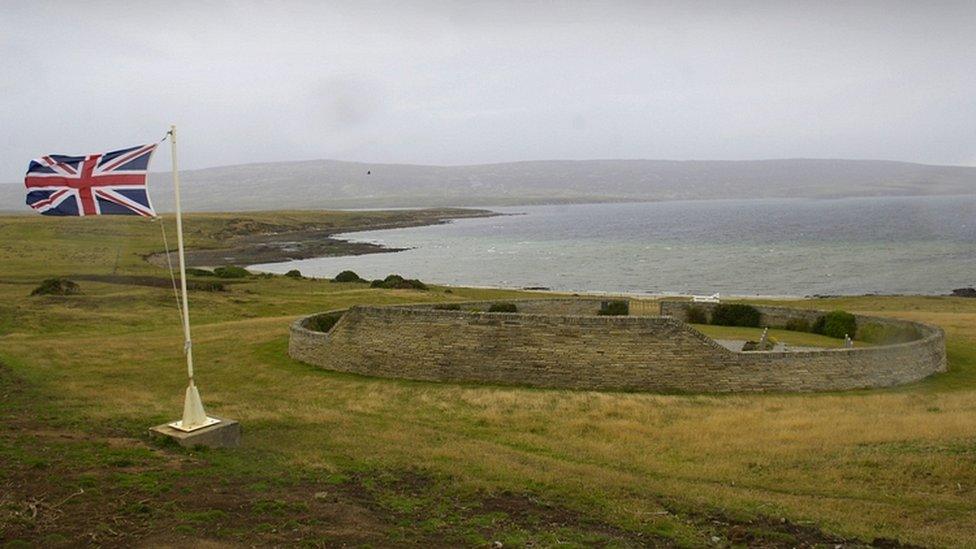
There were 255 British servicemen who died in the Falklands War during the 74-day conflict
Andy left the navy in 2007 but the effects of being on the ship when it was hit were long-lasting. Eventually he was diagnosed with severe Post Traumatic Stress Disorder (PTSD)
"It was tough to get that diagnosis but it gave me some relief to realise I was not mad," he says. "It was an illness."
Andy, who now lives in Scotland and works for a successful company, said the PTSD diagnosis helped him to realise why, when he attended the annual Remembrance service in London, he would suddenly experience smells and other sensations as if he were back on the ship.
He says his mental recovery has not used medication but is self-regulated by gym sessions and having his family with him.
A decade ago he had the chance to speak with the pilot of the plane that hit Sheffield on a radio programme, but turned it down.
But times and Andy have changed.
"I'd want to met the pilot and give him a hug, because that's the way I'm thinking now," he says.
"I get stronger and better as each day goes on".

Follow BBC Yorkshire on Facebook, external, Twitter, external and Instagram, external. Send your story ideas to yorkslincs.news@bbc.co.uk, external.
Related topics
- Published22 November 2018
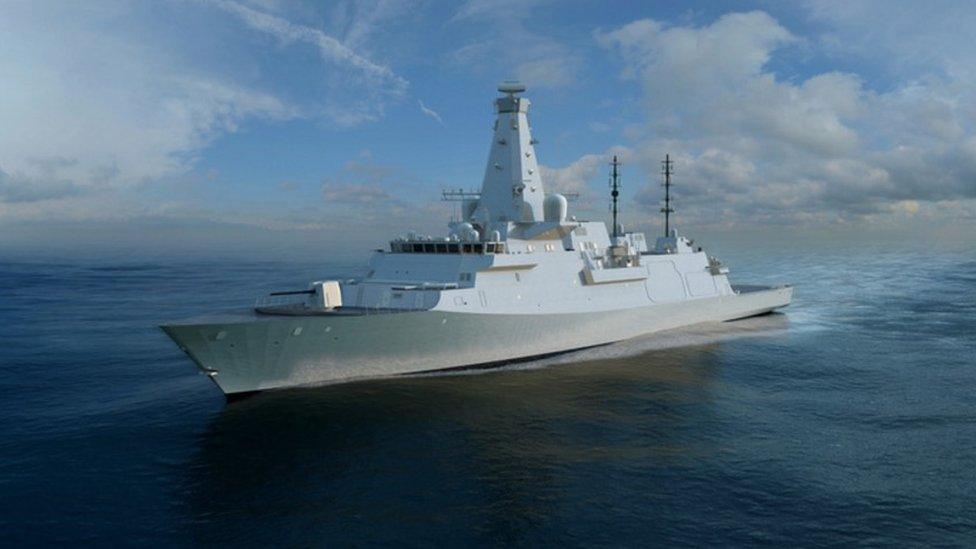
- Published4 May 2012
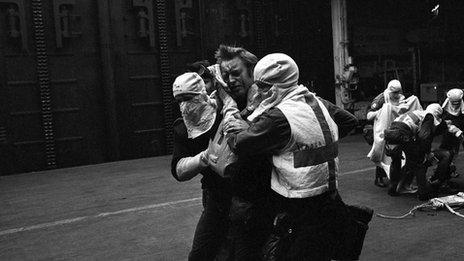
- Published2 May 2012
- Published23 March 2012